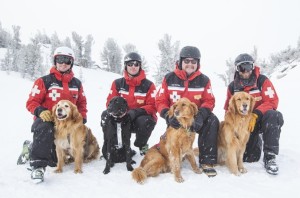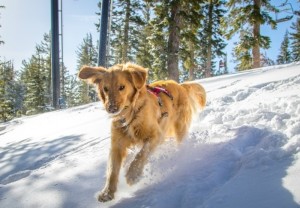Man’s best friend can be quite the ally at a ski resort. That’s right, avalanche rescue dogs play a role at most U.S. ski resorts, including Heavenly Mountain and Northstar California in Lake Tahoe.

Skiers and snowboarders really love the snow, yet so do avalanche rescue dogs. You may have seen dogs riding the lifts, cruising along in a snowmobile, running behind a skier, or just hanging out in anticipation of something taking place. Who knows, a dog may one day play a role in saving your life at a ski resort.
Practically every Western (and European) ski resort has a canine staff, which consists of a team of highly trained rescue dogs who use their speed, on snow agility and incredible sense of smell to locate buried avalanche victims faster than any known alternative.
AVail Resort in Lake Tahoe, Northstar has an avalanche rescue dog named Ruckus. She is trained to find humans who have been buried in an avalanche. Ruckus will respond with her handler to such emergencies on the Northstar property and will assist when called upon for backcountry rescues.
“We use dogs for their amazing sense of smell. This is due to the 220 million olfactory nerves that reside in the nose. Humans have a mere 5 million,” Northstar spokesperson Marcie Bradley said.
Heavenly ski patroller Colton Terry identifies the top five characteristics of a good avalanche rescue dog.
- Good prey drive, which is their desire and drive to locate a victim.
- Good victim loyalty, which will help them to better identify a victims location. With good victim loyalty, they will not leave the area until the handler comes and investigates what they have found. It helps eliminate false indications.
- High energy is a plus. This gives them the ability to search for extended periods of time.
- Obedience. Professional rescues are very serious and involve a lot of distractions and people. The dog needs to stay focused on the task at hand.
- Good physical condition. Avalanche rescue can be very demanding on a dog and requires good physical fitness and agility.This would cover general health, which would include a good sense of smell.
It is believed that one dog and its handler can do the job of 150 trained human searchers in the same amount of time. For much of skiing history, this canine safety net has been hidden behind the scenes, but resorts have given them an increasingly public persona in recent years – and guests love them.
Patrollers typically get a dog as a puppy, in many cases a rescue or shelter dog. It is a one on one relationship where the patroller trains it, lives with it, and eventually and keeps it as his or her pet when it retires. The resort typically covers all the expenses for food, training, and medical expenses.

The good news is that the dogs rarely have any real work to do at the resorts. Although they train hard, “in-bounds” avalanches, within the boundaries of public ski resorts, are extremely rare. In the history of U.S. snowsports, only one skier without an avalanche transceiver has been rescued by a patrol dog within ski resort boundaries – at Wyoming’s legendary Jackson Hole.
But the dogs also do real work. While rarely needed for in-bounds searches, a lot of rescue dogs are also part of regional teams for backcountry emergencies, which are more common.
Many of the resorts sell rescue dog t-shirts or posters as fundraisers for the ski patrol.
The dogs spend their time training and serve as resort ambassadors. Afterall, who doesn’t love man’s best friend!
Jeffrey Weidel can be reached at [email protected]. Follow him on Twitter at @jeffweidel and visit his website at www.tahoeskiworld.com.